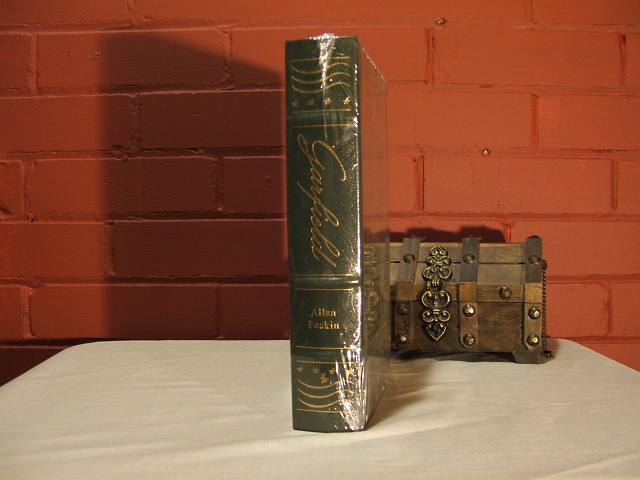Easton Press James Garfield books
Garfield: A Biography - Allan Peskin - 1987
(This page contains affiliate links for which we may be compensated.)
President James Garfield biography
James Abram Garfield (1831-1881), 20th President of the United States, born in Orange, Cuyahoga County, Ohio. He worked on his mother's frontier farm, attended to school in the winter months, and was for a time a steersman and driver on the Ohio Canal. Later, teaching and other part time employment enabled him to acquire the means of securing a higher education. After graduation form Williams College with honors in 1856 he taught at Hiram Institute in Ohio, and served as president of that institution from 1857 to 1859; in the latter year he was admitted to the bar and was elected to the Ohio State Senate.On the outbreak of the Civil War James Garfield was commissioned a lieutenant colonel in the Union Army. A successful campaign in Kentucky led to his promotion to the rank of brigadier general in 1862; and further conspicuous services, including his work as chief of staff to General William Starke Rosecrans, led to his being made a major general in 1863.
While in military service he had been elected a United States Congressman in 1862. On President Abraham Lincoln's advice James Garfield resigned his military commission in December, 1863, and took his seat in the House of Representatives, where he subsequently became an authority on constitutional rights and on education, tariff, and financial questions. He was re-elected eight times, and was a Republican leader of the House from 1876 to 1880. In the latter year he was selected by the Ohio State legislature to fill a vacancy in the United States Senate.
In June, 1880, James Garfield attended the Republican National Convention and supported the candidacy for the Presidential nomination of the statesman John Sherman. However, after thirty-five ballots had failed to break the deadlock between the chief contenders, President Ulysses S. Grant, who was seeking a third term, James G. Blaine. James Garfield was nominated on the thirty-sixth ballot as a compromise candidate. In the ensuing campaign he broke a long standing precedent by making speeches in his own behalf. Elected in November, he was sworn in on March 4, 1881. On July 2, while in the railroad station in Washington, D.C., he was shot by Charles Jules Guiteau, a disgruntled office seeker. After several weeks of painful illness, blood poisoning set in, and he died on September 19. His collected works were published in 1882-1883.
Garfield: A Biography
Garfield: A Biography by Allan Peskin stands as a definitive portrait of one of America's often overlooked presidents, James A. Garfield. Peskin, a distinguished historian, meticulously chronicles Garfield's remarkable journey from humble beginnings to the highest office in the land, offering keen insights into his character, leadership, and the tumultuous times in which he lived. Born on November 19, 1831, in Orange Township, Ohio, Garfield rose to prominence through a combination of intellect, ambition, and hard work. His early years were marked by a thirst for knowledge and a commitment to education, eventually leading him to pursue a career as a teacher and later as a lawyer. Peskin expertly navigates Garfield's formative years, illuminating the influences that shaped his worldview and prepared him for a life of public service.Garfield's political career is a central focus of Peskin's biography, with particular attention paid to his tenure as a congressman representing Ohio's 19th district. As a skilled orator and staunch advocate for civil rights and reform, Garfield quickly gained prominence within the Republican Party and emerged as a key figure in the tumultuous years following the Civil War. Peskin explores Garfield's legislative achievements, including his support for African American suffrage and his efforts to combat corruption in government. The pinnacle of Garfield's career came with his election to the presidency in 1880, a victory that surprised many observers and catapulted him into the national spotlight. Peskin provides a detailed account of Garfield's brief but consequential presidency, from his efforts to unite a divided nation to his tragic assassination by a disgruntled office seeker just months into his term. Through Peskin's narrative, Garfield emerges as a principled leader whose untimely death robbed the nation of a potentially transformative presidency.
Published in 1978, Garfield: A Biography remains a landmark work in Garfield scholarship, praised for its thorough research, insightful analysis, and engaging prose. Peskin's biography offers a compelling portrait of a president whose legacy continues to resonate, reminding readers of the enduring relevance of Garfield's life and ideals.
James Garfield quotes
"The truth will set you free, but first it will make you miserable."
"Next in importance to freedom and justice is popular education, without which neither freedom nor justice can be permanently maintained."
"Ideas control the world."
"If wrinkles must be written upon our brows, let them not be written upon the heart. The spirit should never grow old."
"The world's history is a divine poem, of which the history of every nation is a canto, and every man a word."
"I am trying to do two things: dare to be a radical and not a fool, which is a matter of no small difficulty."
"Poverty is uncomfortable; but nine times out of ten the best thing that can happen to a young man is to be tossed overboard and compelled to sink or swim."
"There is no more dangerous menace to civilization than a government of incompetent, corrupt, or vile men."
"I love agitation and investigation and glory in defending unpopular truth against popular error."
"Be fit for more than the thing you are now doing. Let everyone know that you have a reserve in yourself; that you have more power than you are now using. If you are not too large for the place you occupy, you are too small for it."
